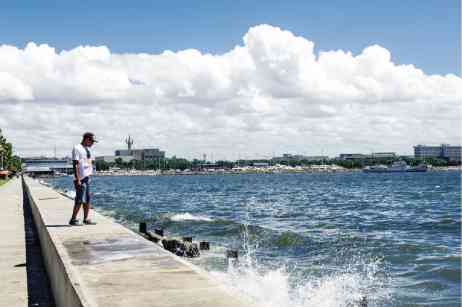
Experts warn that mining of seabed materials would threaten fisheries that provide food and livelihood for Metro Manila and its neighbors.
MANILA, Philippines — Coastal erosion, red tide, and heavy metal contamination are feared along Manila Bay and Lingayen Gulf coasts if the government permits seabed quarrying.
Marine experts warned on Wednesday that the extraction of seabed materials would negatively affect fishing grounds that provide food and livelihood to Metro Manila and its neighboring areas.
“We urge the government to halt these destructive projects immediately before it is too late. It is not enough to merely place a spotlight on the harmful human activities that are slowly killing our planet,” said Oceana Vice President Atty. Gloria Estenzo Ramos in a statement.
“We need to call on our government to act now and not allow such destructive practices to continue,” she added.
Academician Fernando Siringan of the University of the Philippines (UP) Marine Science Institute explained that workers would need to dig through more than 10 meters of mud in the mining activities, which would cause irreversible damage on the seabed and the organisms in it.
“May mga lugar na wala naman dating putik, mapupuno naman ng putik. Mababago ang seafloor, ang benthic habitat at kung anumang organismo na nandoon ay maiistorbo at may masamang epekto sa kanila,” said Siringan.
(Places, where there was no mud before, will be filled with mud. The seafloor, the benthic habitat, and if any organisms in it will be disturbed and have a detrimental effect on them.)
“May mga pag-aaral sa UK na after 15 years of operation ay halos hindi pa nakabalik ang mga organisms na nakatira doon sa seabed,” he added.
(There are studies in the UK that after 15 years of operation the organisms that live there on the seabed have hardly returned.)
Siringan also revealed that seabed quarrying has health risks and could cause cysts of Pyrodinium bahamense, the primary cause of paralytic shellfish poisoning or red tide, to be resuspended from the sediments and release toxins in the water. These may then contaminate mussels and other shellfish harvested and sold in nearby markets.
He also warned that heavy metals in the sediments might also be released into the water channel.
According to Siringan, coastal erosion could also become a problem in the future if seabed quarrying activities continue.
“Kapag binago ang hugis ng seafloor, magbabago rin ang direksyon ng alon. Ito ay magiging sanhi ng mas concentrated na wave energy na magiging sanhi naman ng coastal erosion. Ang pagkabawas ng buhangin sa dalampasigan, parang tinatanggal ang suporta sa upper part ng sediments,” he explained.
(Changes in the seafloor will change the direction of the waves. This can trigger more concentrated wave energy that can lead to coastal erosion. By taking out sand from the shore, you are also removing support from the upper part of the sediments.)
Similarly, Dr. Irene De Vera of the Pangasinan State University warned that drilling in Lingayen Gulf affects water quality, disrupting sea mammals, fish, and plankton.
“Mining is not compatible with Lingayen Gulf. It is used for fishing, tourism and other purposes but not for mining. Due to the deep holes created by drilling, magkakaroon ng coastal or shoreline erosion. Kung magkaroon ng earthquake, mas lalong mag-erode at madi-dislodge ang mga sediments, the water force will go up at maaaring maging sanhi ng tsunami,” De Vera explained.
(Mining is not compatible with Lingayen Gulf. It is used for fishing, tourism and other purposes but not for mining. The deep holes created by drilling may cause coastal or shoreline erosion. An earthquake will intensify the erosion and dislodge sediments, causing the water force to go up and may result in a tsunami.)
“Lingayen Gulf is prone to tsunami, as high as seven meters. Pwede pong mangyari ito,” she added.
(Lingayen Gulf is prone to tsunamis, and an earthquake can trigger a tsunami as high as seven meters.)
Dean of the School of Environmental Science and Management of the UP Los Baños Dr. Rico Ancog then reminded that “in order to be worthy of approval, the benefits of any project that affects the environment must far outweigh the losses. “
“Data show how valuable and thriving the fisheries and aquaculture of Manila Bay are. Economically, Manila Bay is important and wide-ranging. Environmental changes will affect fisheries and aquaculture,” said Ancog.
“There might be negative impacts and when we monetize those negative impacts, the benefits must be significant – up to the point that if we can hypothetically compensate the costs, there should still be net gai” s,” he added.
According to Oceana, the Philippine Mining Act is clear that offshore government mineral reservations do not allow any mineral agreement applications, including large-scale financial, technical agreements (FTAAs). These are critical to preserving minerals for essential industries and scientific purposes, cultural, or ecological value.
This, said Oceana, cannot be superseded by Executive Order (EO) No. 153 (1999) which authorizes the government to use offshore areas not covered by approved mining permits/contracts, including areas covered by pending mining applications, as to borrow areas for dredged fill materials for existing and future government reclamation projects.
The experts issued the statement after President Rodrigo Duterte signed EO 130, which lifted tcountry’sy’s mineral agreements.
READ: Duterte lifts moratorium on new mining agreements
This then lifted the moratorium on new mining agreements imposed by former President Benigno S. Aquino III in 2012, allowing the government to enter into new mineral agreements like seabed quarrying and ore mining activities in Limay, Bataan, Lingayen Gulf, Tayabas Bay, and Cagayan.
RELATED STORY